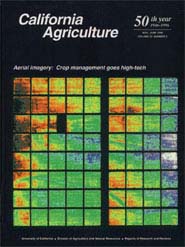Calag Archive
Calag Archive

Aerial imagery: Crop management goes high-tech
Cover:
This computer processed aerial photo of a uniformly managed sudangrass crop grown at the UC Davis Long term research on Agricultural Systems (LTRAS) site prior to starting a 100- year experiment, reveals subtle differences in soil fertility. Computer image courtesy of Ford Denison
May-June 1996
Volume 50, Number 3
Volume 50, Number 3


